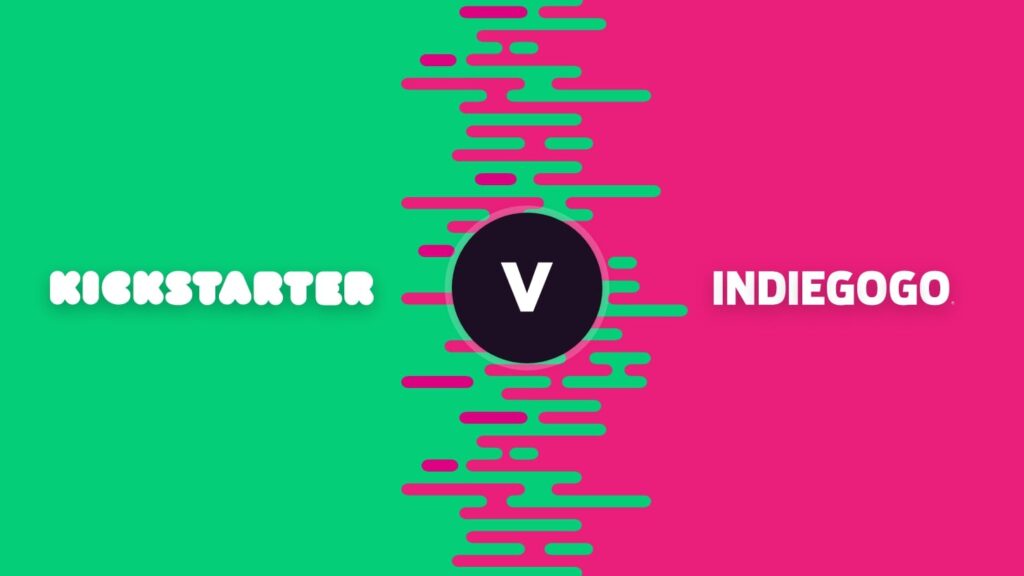
Here’s one of the questions I’ve gotten the most since starting LaunchBoom:
Should I use Kickstarter or Indiegogo to launch my crowdfunding campaign?
Are you ready for everyone’s least favorite answer?
It depends.
Contents
- Key Takeaways
- Kickstarter vs Indiegogo – An Overview
- The Crowdfunding Shakeup
- Which Categories Do Well on Kickstarter and Indiegogo?
- What Won’t Work on Kickstarter and Indiegogo?
- Kickstarter vs Indiegogo: Success Rate
- Kickstarter vs Indiegogo – Funding Differences
- Kickstarter vs Indiegogo – Marketing & Promotion Differences
- Kickstarter vs Indiegogo – Other Differences
- Indiegogo vs Kickstarter: Applying for a Campaign
- Indiegogo vs Kickstarter: Campaign Rules
- Kickstarter vs Indiegogo – Which Should You Choose?
- Kickstarter vs Indiegogo FAQ
Key Takeaways
- Both Kickstarter and Indiegogo are successful crowdfunding platforms.
- Some projects may do better on one crowdfunding platform than on the other.
- Kickstarter works on a fixed funding model while Indiegogo offers flexible options.
Kickstarter vs Indiegogo – An Overview
But really, it does. Each platform has their strengths and weaknesses and there are multiple factors that will play into which platform you should launch on. If you look back on my past blog articles, you can even watch me struggle with this question as I’ve learned more about what types of projects are best for each platform.
By the end of this article though, you’ll have a detailed understanding of each platform and know which one you should launch on moving forward into 2024 and beyond.
Interested in learning more about Kickstarter vs Indiegogo?
Before you start reading, check out this guide from our CEO Mark Pecota!
Kickstarter
If I were to walk up to a random person on the street and ask them to name a crowdfunding platform, I’d put all my money on them naming Kickstarter. The reason why is because Kickstarter has done a better job of making their brand synonymous with crowdfunding.
Even though they started after Indiegogo, they’ve surpassed them in terms of funds raised and daily traffic. As of March 2023, they’ve raised $7,148,341,842 from 235,319 projects and 21,814,609 backers – of those 21.8 million backers, 7,468,277 backed multiple projects.
According to the traffic estimator SimilarWeb, Kickstarter sees an average of 19.5M unique visitors a month.
You can launch your campaign within 15 primary categories on Kickstarter and 155 sub-categories. Kickstarter’s mission is “to help bring creative projects to life.” They backed up that mission by becoming a Benefit Corporation in 2015 – and are still one of the few companies to have done so.
Out of all the categories they have, it’s worth noting that the top 3 categories (as of March 2023) in terms of funding are the following:
- Games: $2.1B
- Design: $1.5B
- Technology: $1.36B
These category stats usually surprise quite a lot of people. They don’t realize that the largest category is Games.
I’ll tell you right now that if you have a game, just stop here and launch on Kickstarter. When it comes to the gaming enthusiast community on Kickstarter vs Indiegogo, the former is far in the lead.
But, if you don’t have a game, then read on!
Indiegogo
Indiegogo broke onto the crowdfunding scene before Kickstarter. It focused exclusively on independent films initially, which is where it got its name. It didn’t take long for Indiegogo to start adding more categories.
Indiegogo is usually considered a more “open” platform. That’s because they have more lax rules around the types of projects that can launch. Plus, they’ve historically been more open to adding requested features, although it looks like Kickstarter is catching up here.
Funny enough, the one thing they are not open about is their stats. Kickstarter has a page dedicated to live updating stats, but Indiegogo’s are harder to gather. We’re still able to gather some metrics through articles written about them and traffic estimator websites like SimilarWeb.
The most recent public data I could find while researching was from an article on April 11, 2018, by Fast Company. In it, Indiegogo stated that they’ve raised close to $1.5 billion on their platform. Just using the average amount raised since its founding in 2007 would most likely put their total raised close to $3 billion as of 2023.
According to the traffic estimator SimilarWeb, Indiegogo sees an average of roughly 5.6M unique visitors a month.
Using these estimates, the main takeaway is that Indiegogo is about a quarter the size of Kickstarter in terms of traffic and half the size in dollars raised. But that does not mean that Indiegogo is 50% as effective as Kickstarter.
There is much more that should be considered when assessing whether to use Kickstarter vs Indiegogo.
In terms of categories, Indiegogo takes a different approach and has three primary categories: (1) Tech & Innovation, (2) Creative Works, and (3) Community Projects. Those are further broken down into 28 subcategories.
The Crowdfunding Shakeup
Before I dive into the nitty gritty difference between the two platforms, I have to talk about something.
In the last 12 months, there’s been a lot of changes in the crowdfunding industry at large. I’ve watched BackerKit launch a competing crowdfunding platform to Kickstarter. I’ve watched competitors go out of business or shift focus. I’ve watched both Kickstarter and Indiegogo get new CEOs. Speaking of the latter…
Indiegogo brought in their new CEO first in March of 2022. Her name is Becky Center. Before Indiegogo she worked her way up through Groupon and then HealthJoy.

Kickstarter answered by bringing in their new CEO in September of 2022. His name is Everette Taylor. Before Indiegogo, he was the CMO of Artsy.

I’ve had great conversations with both of them. They are each bringing fresh perspectives and renewed energy to an industry that, admittedly, was pretty stagnant.
One of the biggest changes that’s happened so far was on Kickstarter’s end. Within a few months of joining, Everette announced that Kickstarter had added the Meta (Facebook) Pixel. This was something that we all had been wanting for nearly a decade.
The Meta Pixel used to be a huge advantage that Indiegogo had over Kickstarter. But that’s no longer the case. From a marketing tools perspective, this levels the playing field between the two platforms.
New leadership on both platforms is exciting. We’ve already seen innovation since they joined and I believe we’ll see a lot more in 2023.
Which Categories Do Well on Kickstarter and Indiegogo?
While both platforms are capable of launching nearly all the same product categories, there are certain ones that perform better depending on the platform. This difference in performance naturally happens because the platforms are public.
For example, when a large campaign launches, other creators from the same category see that success and are more likely to launch on the same platform. Over a long enough time horizon, enough projects from the same category launch on the same platform that a community of backers forms there as well. That community of backers makes launching on the platform even more effective.
Below you can see which specific product categories I’d recommend for each platform:
Kickstarter
- Gaming (tabletop, trading card, etc.)
Like I had said previously. If you have something in the gaming category, Kickstarter is your platform. Here’s an example from our campaign Pericle:

- Graphic novels / books
Graphic novels and books perform better on Kickstarter as well. Here’s an example from our campaign A Gay Man:

- Art / music / film
Arts, music, film… all the rest of the creative categories are no-brainers for Kickstarter.
Indiegogo
- Lodging / glamping / hotels
This is an interesting category that will only work on Indiegogo. That’s because you’ll need to use photorealistic renderings on your campaign page and Kickstarter does not allow photorealistic renderings. Here’s an example from our campaign, Bubble Hotels:
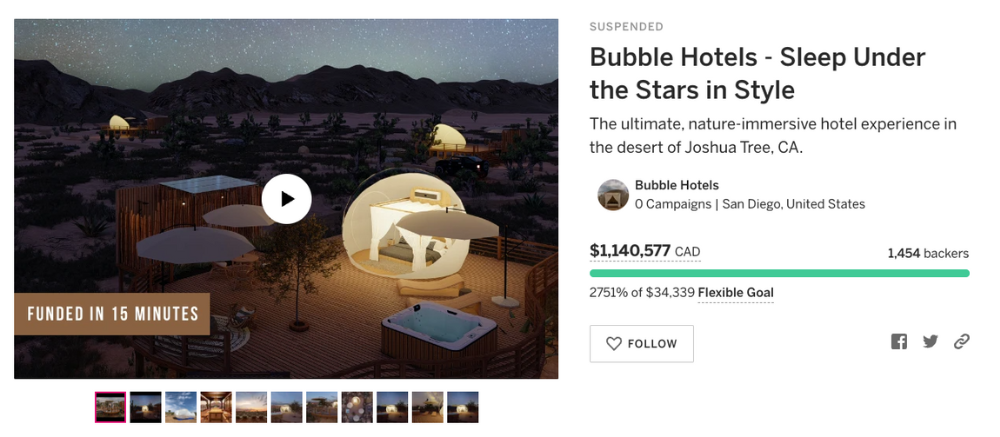
- eBikes
It’s not like eBikes won’t work on Kickstarter, but there’s been a lot more highly successful launches on Indiegogo. Here’s an example from our campaign, Xion CyberX:
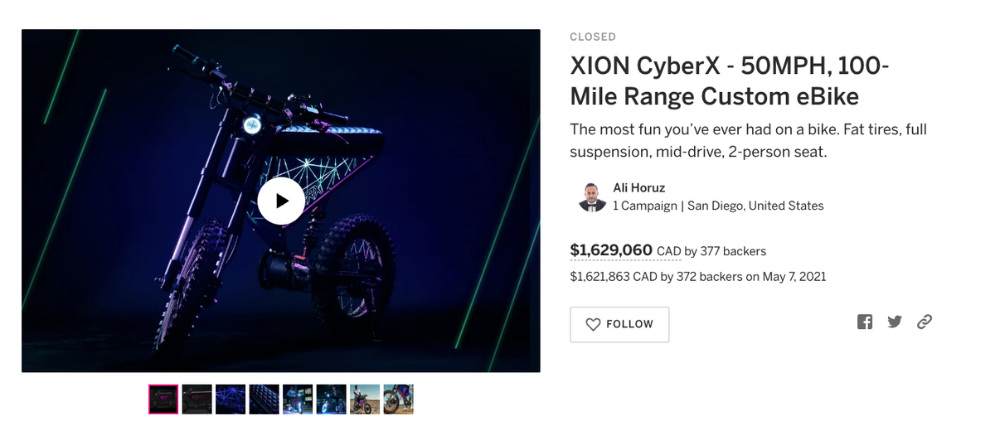
If your project falls within one of these categories, then I recommend you choose accordingly. If not, read on!
What Won’t Work on Kickstarter and Indiegogo?
While the many categories on Indiegogo and Kickstarter allow you to let your dedication go wild, not every project does well on crowdfunding platforms.
Software and apps might not be the best idea for crowdfunding. While there’s no doubt that making an app or a software system takes time and money, it’s not likely to become successful as most apps have a free or low-cost entry point. So there’s no real incentive for a backer to “pre-order” the app.
B2B products usually don’t do well on crowdfunding platforms because backers are primarily consumers looking for physical products or creative projects to back. They’re not looking for service or enterprise solutions. Most backers on Kickstarters are looking for something for themselves or a friend.
Lastly, any get-rich-quick scheme is out. This makes sense since both platforms are based on mutual benefit for the backer and the creator. Both Kickstarter and Indiegogo have strict anti-scam rules, so don’t even think about putting a get-rich-quick scheme on a crowdfunding platform.
Finally, there are banned items, like alcohol, drugs, drug paraphernalia or weapons which are not permitted on either platform. It’s also worth noting that Kickstarter doesn’t allow charities and Indiegogo does.
This includes giving a portion of funds raised on Kickstarter to charity, although you can give your product in a buy-one-give one model.
Kickstarter vs Indiegogo: Success Rate
Kickstarter has successfully funded over 230,000 campaigns and boasts a success rate of just over 40% as of March 2023, which is sure to excite any budding entrepreneur.
On the other hand, Indiegogo’s success rate is more difficult to calculate since the overwhelming majority of creators choose the flexible funding model which means that even if they don’t meet their goal, they still get to keep the money they raised.
Kickstarter vs Indiegogo – Funding Differences
Now that you have a high-level overview of the two platforms, let’s dive into how they differ in terms of how raising funds works.
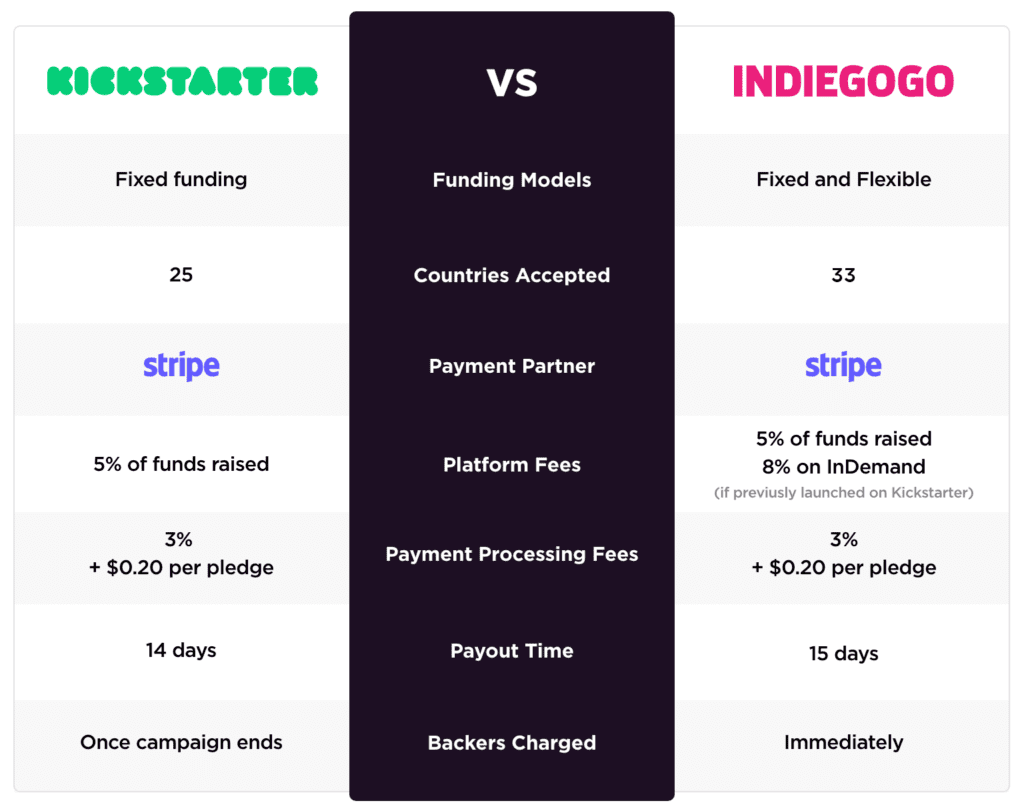
Funding Models
When it comes to funding on Kickstarter vs Indiegogo, there are two models: fixed or flexible.
Fixed funding means if you do not hit your campaign goal within the campaign duration, you do not keep any money and the backers are not charged. Also, the platforms will not take any fees.
Flexible funding means if you do not hit your campaign goal within the campaign duration, you do keep the money and the backers are charged. The platform also takes its fee.
Kickstarter only offers the Fixed Funding model which is why it’s known as the “all-or-nothing platform.”
Indiegogo offers both Fixed & Flexible Funding models and you see the majority of the campaigns choosing the Flexible model. There’s no difference in fee structures for Fixed & Flexible which is why most campaigns opt for Flexible.
Countries Accepted
Both platforms have strict policies for which countries are able to launch. As of January 2023, this is the current breakdown:
Kickstarter: 25 countries.
Project creation is currently available to individuals in the US, UK, Canada, Australia, New Zealand, the Netherlands, Denmark, Ireland, Norway, Sweden, Germany, France, Spain, Italy, Austria, Belgium, Switzerland, Luxembourg, Hong Kong, Singapore, Mexico, Japan, Poland, Greece, and Slovenia.
Indiegogo: 33 countries.
Australia, Austria, Belgium, Canada, Cyprus, Denmark, Estonia, Finland, France, Germany, Greece, Hong Kong (China campaigns may be eligible), Republic of Ireland, Italy, Japan, Latvia, Lithuania, Luxembourg, Malta, Mexico, Netherlands, New Zealand, Norway, Poland, Portugal, Singapore, Slovakia, Slovenia, Spain, Sweden, Switzerland, the UK or US
—
All the countries available on Kickstarter and Indiegogo are directly related to the countries that their payment processor, Stripe, supports.
Important note: if you are outside of these countries, you may still be able to launch using Stripe’s Atlas program. Stripe Atlas allows entrepreneurs to set up a US-based business and bank account which can be used for the crowdfunding campaign.
Payment Partners
Indiegogo used to offer PayPal as an option for payment processing but has recently dropped them in favor of Stripe – just like Kickstarter. Stripe is an incredible payment processor which means you’ll need not worry about payments going through or being handled properly.
The only drawback of using Stripe is that it is more restrictive than other payment processors which is why the countries able to launch on both platforms are fairly limited.
Fees
Both platforms have essentially the same payment processing fee structure since both use Stripe. They are slightly more detailed than the simple 2.9% + $0.30 per pledge (for Indiegogo) and 3% + $0.20 per pledge (for Kickstarter) that I listed in the table above.
For example, pledges under $10 have a discounted micropledge fee of 5% + $0.05 per pledge on Kickstarter. On Indiegogo, you may be charged slightly different transaction fees and transfer fees depending on which country you are coming from.
If the fee structures of these platforms are off-putting to you, it’s important to remember the current state of the global shipping industry (in 2021). Trying to ship products from overseas right now isn’t time-efficient or cost-effective.
Take advantage of the crowdfunding route and don’t worry about the fees they take, because it can save you way more on shipping from overseas amidst this crisis.
Payout Time
You’ve finished your campaign on Indiegogo & Kickstarter so you’re probably wondering… “where’s my money?” Each platform takes some time to process all the transactions and then send the money (minus the fees) to your bank account.
For Kickstarter, it’s simple. There’s a 14-day window for them to go through their processing and then transfer the funds.
For Indiegogo, it’s slightly more complicated. Your initial disbursement is sent within 15 business days after your campaign ends. If you raise more than 1000 in your currency, Indiegogo will automatically hold 5% of your funds in “reserve” for refunds and chargebacks. Reserved funds are held for 6 months after your campaign ends and then transferred to your bank account.
Backers Charged
When someone contributes to a crowdfunding campaign, each platform will handle the payment differently.
For Kickstarter, backers are charged immediately when the campaign ends. That means that a backer who pledges on Kickstarter only has their credit card validated, but they are not charged immediately.
When the campaign ends, Stripe attempts to charge all backers. The drawback of this system is that there will be credit cards that fail to charge for a variety of reasons: insufficient funds, fraud alerts from their bank, etc.
Backers do have one week to correct their credit card information after the campaign ends, but you should expect many of them to never do that. You will not be charged fees on the backers that have failed payments.
On average, we see about 3% of all pledges on a Kickstarter campaign fail. The two factors that contribute the most to the percentage of pledges that fail are (1) your price point and (2) location of your backers.
Higher price points, usually in the hundreds or thousands of dollars, are more likely to fail because banks may flag them as unusual activity. Location can affect it because international backers (in relation to where the campaign launched) are more likely to also be flagged by banks as unusual activity.
For Indiegogo, backers are charged immediately when they pledge on the campaign. This has major advantages for the campaigner since you have an accurate idea of how much you’ve actually raised because you don’t have to worry about failed payments.
Backers are still able to initiate refunds during the course of the campaign, but the refund rates are extremely low in my experience. As stated above, Indiegogo does hold 5% of your funds in reserve for possible chargebacks or refund requests for 6 months after your campaign ends.
Kickstarter vs Indiegogo – Marketing & Promotion Differences
Each platform has different features when it comes to how you can market your campaign on their platform. From tracking tools to promotional opportunities, let’s dive into the key differences.
Google Analytics
Google Analytics is the standard when it comes to free analytics tools for websites. It’s extremely robust out of the box and you’ll want to have it setup for your campaign. Both platforms offer Google Analytics integration easily – all you have to do is put your tracking ID into the backend of your campaign. Check out this article to learn how to do this.
There’s an option in Google Analytics to turn on e-commerce tracking which allows you to understand purchase data from within your Google Analytics account. Both platforms also automatically add the tracking code necessary for you. All you have to do is turn e-commerce tracking on in your Google Analytics account and the platforms will automatically send the data correctly.
Where the platforms differ is in their accuracy around Google Analytics tracking. In my experience, Kickstarter has better integration and the data tracked in Google Analytics almost identically matches the data tracked on your Kickstarter campaign.
Indiegogo usually over-reports the data slightly so it’s important to take this into account when you are looking at the data in Google Analytics if you launch on Indiegogo.
Note that Google is phasing out Universal Analytics (UA) for Google Analytics 4 (GA4) in the near future. GA4 is likely to integrate with anything that UA has successfully integrated with in the past. Kickstarter already offers a how-to for GA4 on its Google Analytics page. It’s best to set up your GA4 tracking now rather than wait until UA is sunsetted completely on July 1st.
Google Ads Tracking
Google Ads is Google’s name for their advertising platform. Within your Google Ads account, you will have a special tracking code to track conversions from your ads.
Indiegogo allows you to add this code to the backend. Kickstarter does not.
With that said, since Kickstarter has Google Analytics tracking, you can still track your Google Ads within Google Analytics, but it won’t show up in your Google AdWords tracking. It’s not the end of the world, but Indiegogo makes it easier to track ads since they allow you to put this code in the backend.
Meta Pixel
Facebook & Instagram, both under their parent company Meta, are by far the largest external sources of traffic to crowdfunding campaigns. The Meta Pixel is a piece of code that allows you to track the effectiveness of your ads – which is extremely important when advertising.
If implemented, you can track important metrics like:
- If someone purchased from an ad
- If someone visited the checkout but didn’t purchase
- If someone visited the campaign page but didn’t purchase
Furthermore, giving Meta this data will automatically make your ads more effective. When the Meta Pixel tracks a purchase, their algorithm automatically starts showing your ads to people like the person that purchased it.
Both platforms allow the Meta Pixel.
Until recently, only Indiegogo allowed you to add the Meta Pixel, which allows creators to take control of their own ads and track purchases from Facebook Ads. With the addition of Meta Pixel, Kickstarter has now evened the playing field and made it easier to advertise your campaign. This move from Kickstarter is a huge step to empowering creators and creating a healthier crowdfunding ecosystem.
Tracking Links
Over the past couple of years, both platforms have added the functionality for you to create your own tracking links from within their platform. This means that you can quickly create unique links that will be tracked from within the platform’s dashboards.
This isn’t a huge feature, but sometimes it’s nice to have an easy way to create a tracking link you use for marketing efforts.
Promotional Opportunities
Like we talked about earlier, both platforms combined have millions of unique visitors a month. The platforms know this and take advantage of those eyeballs by offering promotional opportunities to some campaigns. How you get the promotional opportunity and what is available is where the platforms differ.
On Indiegogo, it’s easier to tap into their promotional opportunities. Two of the most effective opportunities they offer are (1) newsletter placement and (2) homepage placement.
If your campaign is doing very well, they will likely reach out to you about these opportunities. Some of them may have added costs such as a higher commission from sales that come through those sources. They even offer contracts to some creators for hitting certain funding milestones. For example, you may hit $100K in funding, and they’ll put you in their newsletter.
Indiegogo will also offer a schedule of continuous newsletters with multiple thresholds. For example you may be able to negotiate a deal where they will include you in the newsletter when you launch, when you are 50% funded and when you are 100% funded.
These promotional efforts from Indiegogo can send a lot of sales – especially if you get a top spot. For example, check out the chart from the VAVA 4K Laser Projector campaign we launched on Indiegogo. Each of the spikes in sales I call out are when Indiegogo sent newsletters. Some of those spikes were over $50K in funding in one day.
Kickstarter treats promotions differently. They have newsletter promotions, homepage placement, and also their coveted “project we love” status. Each of these promotions are much harder to get, but if you get promoted by Kickstarter, it can be very effective.
Luckily, Kickstarter offers some tips on how to get those placements. For “projects we love” they pay closer attention to campaigns that have a crisp project image with no logos, badges, or text on top, captivating images or videos, and an excited community. They also place a lot of value in honesty and look for as much detail as possible and a thorough plan for completing your project. For this last one they also offer a guide here.
For the projects they feature on their homepage Kickstarter says they look for, “creative innovation, honesty, and alignment with Kickstarter’s mission and charter.” But they also consider campaigns that have been successfully promoted by the creators themselves. This is why working with a Kickstarter Expert, like LaunchBoom, can increase your chances of getting promotions from Kickstarter.
Add-ons
Upselling is a tactic where when someone goes to purchase an item, you immediately offer them another item to add to their order. This is a staple of any e-commerce marketing strategy. Indiegogo started offering this in 2019. More recently, Kickstarter began offering this feature as of early 2021.
Add-ons work really well. When they first came out in 2019, we tried it for our client AIR PIX. We were able to raise an additional $133,844 in sales just from our Custom Charging Case add-on. That’s nearly a 10% lift in sales just by adding one add-on to the campaign!
Secret Perks/Rewards
A secret perk/reward is a product offering on the platform that only appears if someone clicks on a specific, unique link. Indiegogo pioneered this feature, and Kickstarter has not followed in its footsteps yet.
This is a valuable feature since it allows you to be more creative with your marketing strategy. For example, you can offer a secret discount to people that sign up on your email list during the prelaunch. Or, you can use Facebook advertising to remarket the product with free shipping to people that got to checkout and didn’t buy.
It’s one of our favorite features on Indiegogo.
Limited Perks/Rewards
Limited perks/rewards are ones that have a limited amount of quantity or time available. Both platforms offer some variation of this, but Kickstarter’s is more robust.
On Kickstarter, you can limit a reward by both quantity and time. That means you could create a reward that only has 100 available and will end at midnight on a certain day. This gives you the opportunity to create promotional strategies using scarcity and urgency – which are both very powerful marketing tactics.
On Indiegogo, you can only limit a reward by quantity. They have not added time limits yet.
Kickstarter vs Indiegogo – Other Differences
Here’s a handful of other notable differences between the platforms.
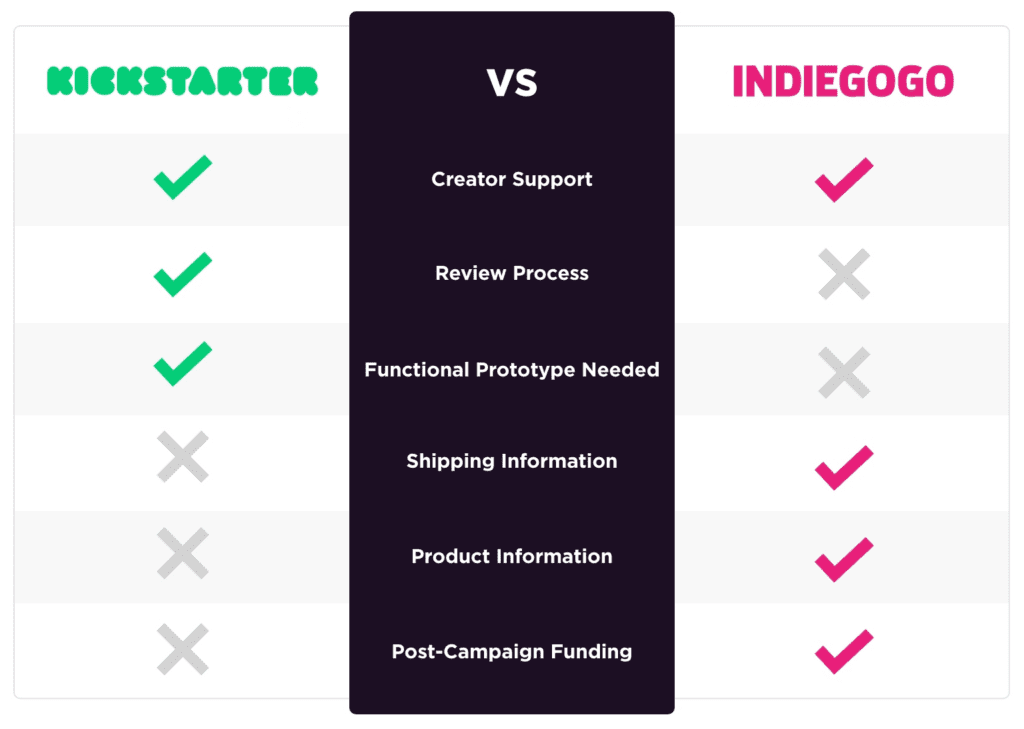
Creator Support
Each platform strives to provide the best creator support. When I say creator support, I mean their willingness to help you with your crowdfunding campaign – everything from promotional opportunities to answering basic questions about how to crowdfund. It’s possible to talk to someone on the phone at each platform, but it’s not very likely. Less than 10% of campaigns that reach out will get offered a call.
Kickstarter offers comprehensive FAQs on their website that addresses all the questions you might have from prelaunch to after your campaign ends. If you don’t find the answer you are looking for, you can create a support ticket. Kickstarter aims to respond within 4 hours. If you want to get on a call with Kickstarter, it doesn’t hurt to ask, but like I said before, it’s not likely they’ll say yes.
If you are looking for professional support, Kickstarter has their Kickstarter Experts directory. Each consultant listed isn’t affiliated with Kickstarter but has been vetted by their team. LaunchBoom has been a Kickstarter Expert since the program started.
Indiegogo also offers comprehensive FAQs. Just like Kickstarter, you can submit a support ticket if you don’t find what you’re looking for. If you’re interested in contacting Indiegogo for promotional opportunities, I suggest that you fill out this form instead of submitting a support ticket.
Indiegogo also has an Experts Directory. Everything ranging from legal to marketing support can be found in their Directory. LaunchBoom has also been an Indiegogo Expert since they first created the directory.
Tipping
Indiegogo added a tipping feature in 2022. What this does is add an optional tip to checkout for the backer. This tip goes 100% to Indiegogo and looks something like this:
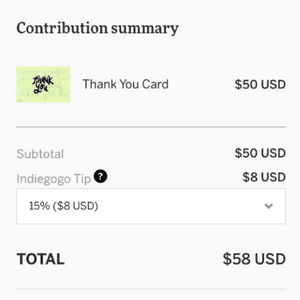
There is no way to turn this feature off. Indiegogo claims that this doesn’t affect the conversion rate in a negative way, which I can’t confirm. But I can confirm that it doesn’t help anyone but Indiegogo.
Kickstarter does not have the tipping feature.
Indiegogo vs Kickstarter: Applying for a Campaign
Kickstarter & Indiegogo approach the “review” process very differently and have different rules about the types of projects that are allowed on their platforms.
As stated before, Indiegogo is generally a more open platform and doesn’t require that you go through any review before you launch. That doesn’t mean they don’t have rules though, and their team will still shut your campaign down (no matter how much you’ve raised already) if you don’t follow them.
Kickstarter has a manual review process that usually takes 3-5 days. This is why on Kickstarter, it’s very important to factor the time it takes to get through the review process into your timeline for launching. Best practice is to submit your campaign for review at least 7 business days prior to your launch date.
Indiegogo vs Kickstarter: Campaign Rules
While you might want to set yourself apart from the competition and break some rules along the way, you’ll also want to learn the rules of Kickstarter and Indiegogo and stick to them.
There’s not too much to worry about, though: all the rules are pretty straightforward.
Kickstarter has five main rules that all campaigns should follow:
- Projects must create something to share with others.
- Projects and backer statistics must be honest and clearly presented.
- Projects can’t fundraise for charity.
- Projects can’t offer equity.
- Projects can’t involve prohibited items.
Indiegogo also has a basic set of rules you have to follow in order to use their platform:
- Prohibited behavior includes harassment, hate speech, dishonesty, spam, nudity, and graphic or violent content.
- Gambling, investments, profit sharing, and drug or alcohol references are prohibited.
- All projects must provide monthly updates for backers and perks must be fulfilled.
- Cross-promotion is forbidden.
There are also some additional things you’ll want to keep in mind before, during, and after your campaign that are crucial to your success.
Functional Prototype
A functional prototype is one that actually has all the features you claim your product will have in your marketing. Functional does not mean it has to look good though. Many creators who have more technologically advanced products may have multiple prototypes: one that is visual and one that is functional. We use the visual prototype to create all the marketing and the functional to prove it can do what we say it can do.
On Indiegogo, you do not have to have a functional prototype to launch. If you don’t have a functional prototype though, you must clearly state that your project is in the “concept” phase.
On Kickstarter, you must have a functional prototype and clearly show the functional prototype working on your campaign page.
Shipping Information
You’ll need to gather accurate shipping information from your backers to ship your product once you’ve finished manufacturing.
On Indiegogo, your backers will give this information when they checkout.
On Kickstarter, backers are not able to give this information when they checkout. For this reason, you are required to send surveys after your campaign is over to gather this information. Kickstarter has built-in surveys you can use, but they currently aren’t very robust. That should change soon though because as of February 27, 2023, Kickstarter announced they are partnering with PledgeManager.com. As of writing this, the details between their partnership are very light but we think that will change very soon.
As of 2023 both platforms are also now partnered with Easyship.
Indiegogo has offered integration with Easyship for a few years now and comes with complimentary logistics consultations, access to their dashboard for label generation and account integration/management, access to over 250 global shipping companies, a breakdown of taxes and duties around the world, and more features that streamline the shipping process.
Kickstarter’s recent deal with Easyship offers creators waived membership fees and discounted shipping rates when signing up with Kickstarter and syncing your crowdfunding campaign with Easyship. For campaigns with more than 500 backers, Easyship will also offer their Easyship Collect feature for free. This feature allows you to offer your backers upgraded shipping options and allows you to charge for shipping costs after the campaign has ended.
Product Information
Let’s say that you are crowdfunding a new pair of shoes. Unless you’ve invented one size fits all shoes, you’ll need to know which size your backer wants before you ship them out.
On Indiegogo, you are able to create product variants, like size or color, when you create your perks. Backers are able to choose their desired product variant when they go through the checkout process.
On Kickstarter, you are not able to create product variants when you create your rewards. Like shipping information, you must follow up with your backers post-campaign with a survey to gather this information.
Post-Campaign Funding
After your campaign funding duration is over, you’ll want to continue pre-selling your product.
On Indiegogo, your campaign can automatically convert to an InDemand campaign where the campaign duration and funding goals don’t apply anymore – essentially turning your Indiegogo page into a pre-order page for your product.
On Kickstarter, there is no post-campaign funding feature. Instead, Kickstarter allows you to add a button to the top of your Kickstarter page which is called Spotlight. However, Indiegogo does allow Kickstarter campaigns to transition to Indiegogo InDemand when their campaign is over.
It’s recommended to launch an Indiegogo InDemand campaign immediately when your Kickstarter campaign ends and direct your Kickstarter Spotlight to your InDemand campaign. It’s important to note that InDemand increases their fee from 5% to 8% if your campaign originated on Kickstarter. They do this to incentivize you to launch on Indiegogo.
Kickstarter vs Indiegogo – Which Should You Choose?
So, what do you think… which one is better: Kickstarter or Indiegogo?
Armed with all of this information, you’re now able to make a much more informed decision when choosing between Kickstarter and Indiegogo.
And the good news is, no matter which you choose, you’ll be okay. Both platforms are great in their own ways. Plus, there are way more important aspects of your launch strategy that will have much more effect on your campaign success than the platform you choose.
One thing, for sure, is that you shouldn’t feel like you have to tackle this big question alone. If you’re still not positive about which platform is right for you, you can do a bit more reading on it here and book a call with us so we can help you through it.
Kickstarter vs Indiegogo FAQ
Is Kickstarter or Indiegogo Better?
Kickstarter and Indiegogo are both successful crowdfunding campaigns with different perks, one might be better than the other depending on the category of project.
Can You Do Kickstarter and Indiegogo at the Same Time?
While it is possible to run campaigns on more than one platform at once, it’ll confuse your backers, split your funding, decrease your momentum, and lower your chance of success. You’re also not likely to get more exposure.
Is There Anything Better Than Kickstarter?
Kickstarter is currently considered one of the best crowdfunding platforms. It’s certainly the most popular, and for good reason.
What Percentage Does Kickstarter & Indiegogo Take?
Kickstarter takes a 5% fee off of the total amount of money backed by contributors, plus the 3% stripe fee, as well as a small additional fee for each pledge, which can vary by location and currency.






